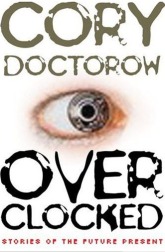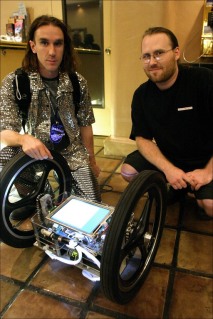Posts Tagged ‘Blog’
Warming up for Picnic ’07
Picnic ’07, Amsterdam’s annual event organized by the Cross Media Week Foundation focusing on creativity in cross media content and technology, is only a month away and the list of speakers is nearly finished. Between the 25th and 29th of September, Amsterdam’s Westergastfabriek will once again host the event after the succes of last year’s edition. But with such a diverse and wide-ranging programme, where will you go? In order to get into the mood and warm up for the event, it is worthwhile to highlight some of the fascinating speakers and take a more in-depth look at what they are all about.
Reuben Steiger (Former Linden Labs Evangelist and founder/CEO Millions of Us)
 At Picnic ’06 Philip Rosedale of Linden Labs / Second Life presented his take on ‘the empowerment offered by Second Life of the average citizen to not only create but monetize their own content and design’. This year former Linden Labs Evangelist Reuben Steiger will take the stage at Picnic’s Virtual Worlds, which is all about virtual worlds becoming central to the future of marketing, technology, entertainment and brand-building. After his work at Linden Labs, Steiger founded and became CEO of Millions of Us, a company dedicated to helping businesses understand and harness the power of virtual worlds. An example is the Toyota Scion car in Second Life.
At Picnic ’06 Philip Rosedale of Linden Labs / Second Life presented his take on ‘the empowerment offered by Second Life of the average citizen to not only create but monetize their own content and design’. This year former Linden Labs Evangelist Reuben Steiger will take the stage at Picnic’s Virtual Worlds, which is all about virtual worlds becoming central to the future of marketing, technology, entertainment and brand-building. After his work at Linden Labs, Steiger founded and became CEO of Millions of Us, a company dedicated to helping businesses understand and harness the power of virtual worlds. An example is the Toyota Scion car in Second Life.
Being an evangelist and clearly someone who believes in the power of virtual worlds, Steiger fights of recent criticism of Second Life as a branding tool at influxinsights.com by saying that ‘some of the criticism is partially warranted, but a lot of it is poorly contextualized and opportunistic, in the sense that pundits love to tear down technologies that have ridden a wave of hype. IT analyst firm Gartner calls this the hype cycle – new technologies spark a wave of initial excitement, expectations inflate, the technology is found to be imperfect in some ways, and there is a backlash – but in the long term, a good technology will overcome the hype cycle and enjoy long-term adoption.’ Are virtual worlds all that Steiger says they are, or just a big bubble? Are you a skeptic or an enthusiast? Not sure? You can find out at Virtual Worlds. In the video below Steiger answers questions on his personal interest in Second Life and if virtual worlds are a response to alienation in real-life.
When? 27th September 14.00 – 17.00
Where? WesterUnie
What? Virtual Worlds at Picnic ’07
Cory Doctorow (SF novelist, blogger, technology activist)
 Cory Doctorow, co-editor of popular weblog BoingBoing and contributor to the likes of New York Times and Wired, explores the benefits and consequences of online systems in his latest (fictional) book Overclocked: Stories of the Future Present (free download). This provocative collection of six previously released stories shows Doctorow extrapolating todays user experiences towards a futuristic vision and creating fascinating stories in doing so. An extensive review can be found at The Uberreview. For his writings, Doctorow has already been compaired to ‘Cyberspace’ godfather William Gibson by Entertainment Weekly. In the Authors@Google series Cory Doctorow himself presents and discusses the book, if any questions remain be sure to go see Doctorow at Fab, or the personal fabrication revolution.
Cory Doctorow, co-editor of popular weblog BoingBoing and contributor to the likes of New York Times and Wired, explores the benefits and consequences of online systems in his latest (fictional) book Overclocked: Stories of the Future Present (free download). This provocative collection of six previously released stories shows Doctorow extrapolating todays user experiences towards a futuristic vision and creating fascinating stories in doing so. An extensive review can be found at The Uberreview. For his writings, Doctorow has already been compaired to ‘Cyberspace’ godfather William Gibson by Entertainment Weekly. In the Authors@Google series Cory Doctorow himself presents and discusses the book, if any questions remain be sure to go see Doctorow at Fab, or the personal fabrication revolution.
When? 28th September
Where? WesterLiefde
What? FAB, or the personal fabrication revolution
Pablos/Paul Holman (Futurist, IT security expert, notorious hacker)
From an interview with Pablos “Paul” Holman at DLD ’07, shown in video below, comes the following provocative quote on creativity in companies: ‘Especially large companies tend to be poor at doing new things. They have lots of resources, lots of people and a lot of infrastructure . But all that gets in the way of when you’re trying to be creative. […] Ideally for me, I’d be able to wake up in the morning and dream up something I’ve been dreaming about. Then go build it by lunchtime, launch it in the afternoon and see if people like it. And then maybe fix some bugs by dinner.’
 Contrary to Doctorow, Holman does not read science fiction because he doesn’t want to be accused of plagiarism. His views however are, as the Picnic website also mentions, unique. With his design studio Komposite he ‘consults on bizarre invention and design projects that assimilate new technologies’. To give you an idea: Among his projects is the Hackerbot, a WiFi seeking robot that can find you when you’re using a wireless network – and drive up to show you your password on its screen. According to the Hackerbot website, the robot is really quite friendly and tries not to show your passwords to anyone else. Interested? Be sure to check out Holman at Picnic ’07, also if you’re interested in salsa dancing!
Contrary to Doctorow, Holman does not read science fiction because he doesn’t want to be accused of plagiarism. His views however are, as the Picnic website also mentions, unique. With his design studio Komposite he ‘consults on bizarre invention and design projects that assimilate new technologies’. To give you an idea: Among his projects is the Hackerbot, a WiFi seeking robot that can find you when you’re using a wireless network – and drive up to show you your password on its screen. According to the Hackerbot website, the robot is really quite friendly and tries not to show your passwords to anyone else. Interested? Be sure to check out Holman at Picnic ’07, also if you’re interested in salsa dancing!
When? TBA
Where? TBA
What? Pablos Holman
Stefan Sagmeister (Graphic designer and typographer)
 You might have seen Stefan Sagmeister‘s design in your local record shop on the covers of Rolling Stones, Lou Reed and Talking Heads recordings. The Picnic website mentions that just as film, art, music and literature have the power to move people, Stefan Sagmeister’s innovative work shows that graphic design, too, can cut to the emotional core. An in-depth interview with Sagmeister can found at designboom.com. The image is courtesy of Grafik-freunde Stuttgart.
You might have seen Stefan Sagmeister‘s design in your local record shop on the covers of Rolling Stones, Lou Reed and Talking Heads recordings. The Picnic website mentions that just as film, art, music and literature have the power to move people, Stefan Sagmeister’s innovative work shows that graphic design, too, can cut to the emotional core. An in-depth interview with Sagmeister can found at designboom.com. The image is courtesy of Grafik-freunde Stuttgart.
In 2004 Sagmeister spoke in Monterey, California about how design can make us happy and more specifically design that made him happy on a personal level. Telling stories ranging from billboards and museum exhibitions to pictorial language, Sagmeister is able to show how design can touch a nerve. Design never felt more personal while listening to Sagmeister’s presentation and his words seem far removed from corporate thought. Anyone intested in the emotional side of creativity, and creative industries in general, should see Sagmeister at Creative Genius: Things I Have Learned So Far at Picnic ’07.
When? 27th September 16.50 – 17.20
Where? Zuivering West
What? Creative Genius: Things I Have Learned So Far – Stefan Sagmeister
Various Meetings and (Un)Common Ground
Like last year, Picnic also hosts various meetings such as Virtueel Platform’s (Un)common Ground II: An expert meeting that brings together all the top thinkers in the industry. This year the sub-title is Scale and Intimacy. At the meeting experts will take a close look at the complex issues arising when practices and models of collaboration move across different scales. Like Stefan Sagmeister in his presentation, questions such as ‘how to maintain the emotional connection that people make to the ideas that are promoted or the services or products that it delivered’, are asked. Although the meeting is ‘invitation only’, be sure to check out Virtueel Platform’s publication (Un)common ground. Creative encounters across sectors and disciplines for more information.
For information on all Picnic ’07 events (25th – 29th of September) go to the Picnic network website. Oh… and did I mention Andrew Keen (see my previous post) will also be there?
Vers Geperst: Fresh juice for the brains
Last week I attended the Vers Geperst meeting at Club 11 to tell the audience about the Masters of Media weblog project. Based on the Pecha Kucha presentation idea, all the presenters had only 11 slides of 12 seconds each to propagate their views.

Besides the Masters of Media blog, some other interesting ideas were pitched. What about the already famous ‘Whatever’ button? Are you tired of all the times you have to agree to useless legal information? Just install the Whatever button Firefox extension and you don’t have to worry about all the nonsense anymore! Although I had already installed it before the presentation, Michael Stevenson’s talk and imagery still gave me stomach cramps from laughing.
Another idea came from the guys from ToxTox TV. According to the creators ‘ToxTox is the next generation internet television platform. It allows you to watch video content from your couch, on your tv, using only open software.’ An ambitious idea with lots of opportunities and I’m anxious to see how this works on my television.
The Open-Search project, presented by Erik Borra, focusses on the role of privacy and search engines. The Open-Search project steers away from the centralized powers of the corporate search engine and provides ‘an exemplary peer to peer, collaborative event, whereby people mutually form a search engine without the intervention of central servers or a central actor.’ Definitely worth checking out.
The last presenter I want to mention is Anne Helmond, who is responsible for the lovely Fidel Castroian picture of myself in this post. She presented her photography and also a project she did on drapes and windows. More photographs of the meeting are available on Anne’s Flickr account.

